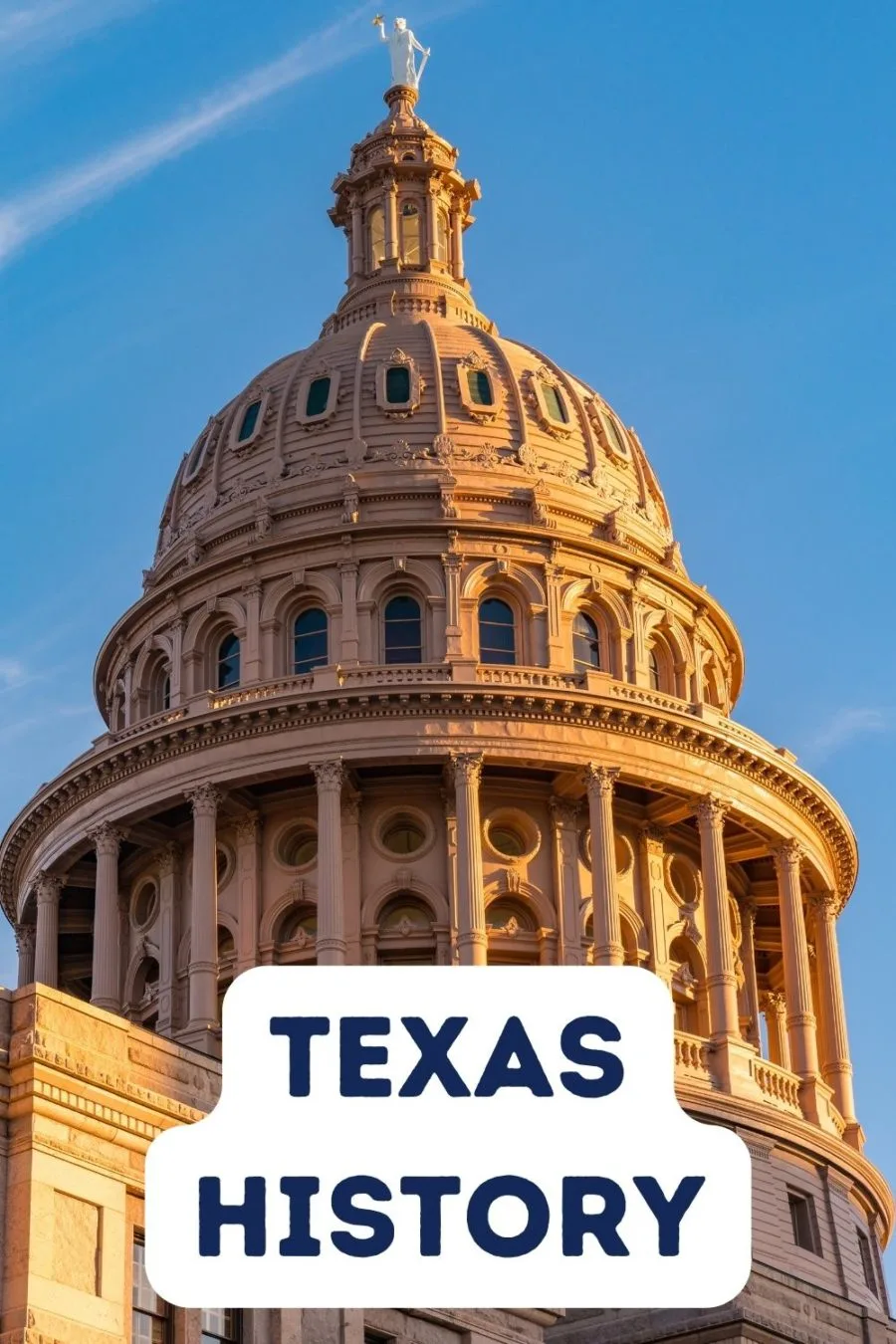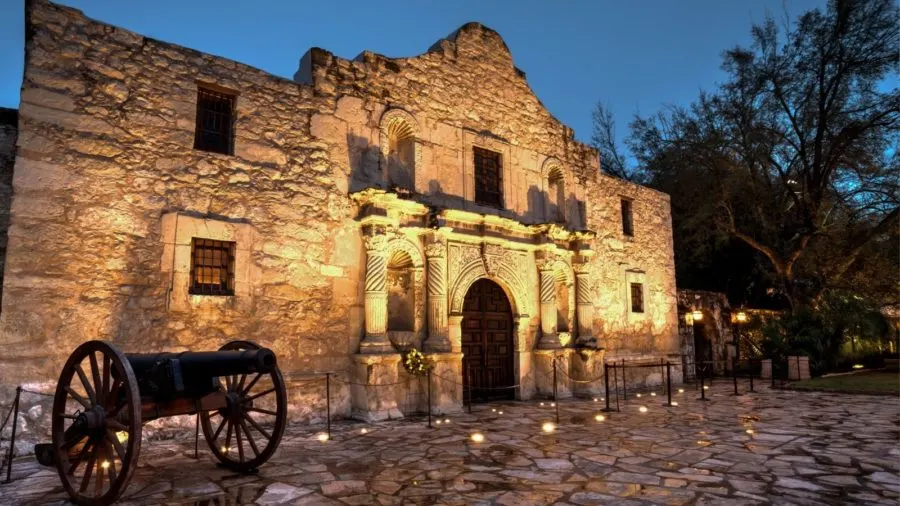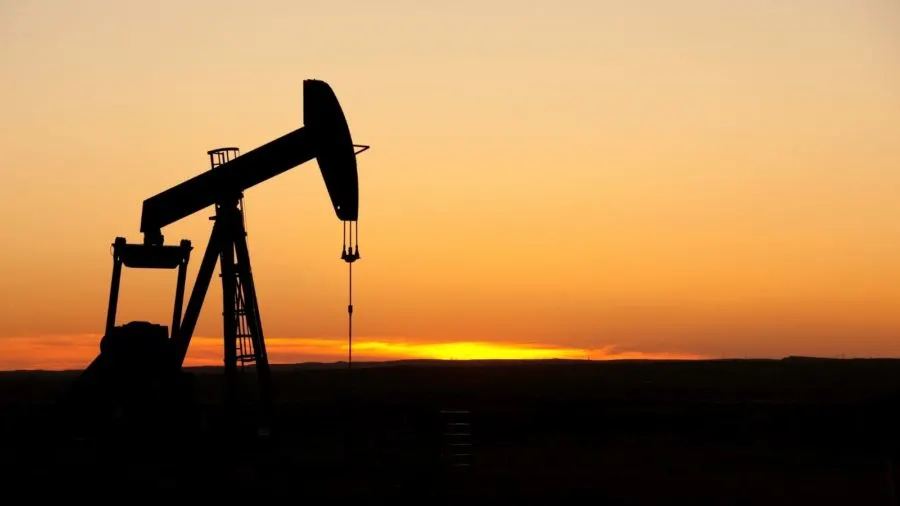The history of Texas begins more than 12,000 years ago when prehistoric peoples of the High Plains first inhabited the area. Europeans first came to the region in 1519, eventually introducing ranching to the area as well as horses.
Table of Contents
Why Did Texas Have Six Flags?
The Spanish flew the first of six flags that marked this area once known as Tejas; the subsequent entities to hoist flags over the region were France, Mexico, the Confederacy, the Republic of Texas and the United States.

Want a breakdown of Texas history by year? See our Texas History Timeline
Spanish Missions Across Texas
In the late 1600s, the Spanish started to establish a system of missions in the piney woods, gradually moving west and eventually reaching the central plains when San Antonio de Valera (later known as the Alamo) was founded in 1718.
The missions were intended to convert Native Americans to Christianity. To encourage European migration to the region, the Spanish granted land to colonists.
In 1821, Spain lost Mexico; in the meantime, Mexico, busy elsewhere, held a loose control over those settlers in present-day Texas.
Settlers Arrive and the Texas Revolution Begins

The Americans and British settlers were in favor of Anglo-American jurisprudence, Protestantism, decentralism, and slavery–all against the laws of Mexico.
As immigration grew, the tensions increased, culminating in the Texas Revolution (1835-36). After a short skirmish, the Mexican soldiers withdrew but in early 1836, a large Mexican army under the command of General Santa Anna marched toward San Antonio.
The battle of the Alamo followed as the larger Mexican army prevailed. On March 6, 1836, the Alamo fell; all its defenders including Davy Crockett, James Bowie and commander William B. Travis, were killed.
The victory was costly for General Santa Anna with one-third of the army sustaining casualties.
A little over a month later, Santa Anna was defeated by Sam Houston and his men at the battle of San Jacinto with the cries of “Remember the Alamo.”
That stint as an independent nation from 1836 to 1845 makes Texas unique. It’s the only U.S. state to ever serve as a sovereign nation. In Austin, visitors can tour an historic foreign embassy, a reminder of the days of independence.
The Republic of Texas, 1836-1845
Many Texans note with pride that Texas was once an independent nation, the Republic of Texas.
Following the Texas forces’ victory over Santa Anna at the battle of San Jacinto, a new government was organized. In September, 1836, the hero of San Jacinto, Sam Houston, was elected the first president of the Republic of Texas.
Among Houston’s first concerns after his inauguration on October 22, 1936 was the continued threat of attack by hostile Indians and the fear of renewed attempts by Mexico to once again extend its borders across the Rio Grande into Texas.
Houston also was eager to establish diplomatic relationships with other countries, including the United States. Initial attempts to forge foreign relations proved difficult for the fledgling nation, however. A breakthrough came with the signing of a trade treaty with Great Britain.
Eventually, the young republic was recognized by France, Belgium, the Netherlands, and the German states. The United States, fearing the effects of an alliance between Texas and Great Britain, recognized Texas as a sovereign nation in 1837.
Establishing a Permanent Capital
In 1839, a permanent capital was established at the frontier village of Waterloo, located on the east bank of the Colorado River north of Bastrop.
The name was changed to Austin and the government was moved in October of 1839. That same year, a new national flag was adopted featuring a single five-pointed star on a field of blue, flanked by horizontal red and white stripes.
Texas Becomes a State
In 1841, Sam Houston was elected to a second term as President of the Republic. Much of his effort during this term was directed toward achieving statehood within the United States.
On October 13, 1845 the people of Texas voted 4,245 to 257 in favor of annexation.
U.S. President Polk signed Texas’s admittance to the union in December of that year. On Feb. 19, 1846, the flag of the Republic of Texas flew over Austin for the last time.

Sam Houston was elected first president of the Republic of Texas. Texas remained a separate country until 1845 when the US government agreed to allow another slaveholding state into the Union.
In 1860, Texas seceded from the Union but remained largely out of the Civil War. The last battle of the Civil War was fought in Brownsville by Texas troops who didn’t know yet that the Confederacy had already fallen.
Cattle Country

When the war ended, ranchers began driving their cattle east to markets in Kansas and Missouri and the period of the American cowboy was begun.
By the end of the Civil War severe meat shortages led to new strategies by Texas cattle suppliers. The most dramatic solution was the cattle drive, whereby cowboys in South Texas collected enormous herds of wild and range cattle (“mavericks”) and drove them north to markets and railroads in Kansas.
Although the heyday of the cattle drive only lasted about a dozen years, its influence persists to this day in popular myth.
Descendants of Andalusian and Castilian breeds brought to the New World by the Spaniards, the Texas Longhorns roamed freely over the Texas and Mexico grasslands, numbering in the millions by the time of the first cattle drives in the late 1860s.
Cowboys would roam these unfenced plains, gathering herds for the long trip to the Kansas markets. Along the way lay many hazards: Apaches and Comanches, cattle thieves, treacherous rivers and inclement weather, as well as the normal hardships of life on the range.
The Chisholm Trail was one of the most famous of the cattle drive routes. It led through San Antonio and Austin and north to Fort Worth, the last “civilized” stop before the Indian Territory of Oklahoma. In Cowtown, the cowboys refreshed themselves against the rigors of the trail in the city’s numerous saloons and brothels. As the herds thundered down Commerce Street, townsfolk knew to stay off the streets. In 1870, 300,000 cattle were driven from Texas to Kansas.
By the late 1870s the railroad was pushing south and west, eventually making the cattle drive obsolete. Yet, along the Chisholm Trail and particularly in Fort Worth, its legacy lives on at sites such as the Stockyards and Sundance Square.
Oil Discovered in Texas

In 1901, oil was discovered in Texas and dominated the state’s economy for the next 80 years. When the wells began to dry up and oil was discovered in other parts of the world, Texas’s economy became decentralized. Today the state has a broad-based economy which continues to include ranching and oil but also boasts many high-tech industries, especially in the Austin area, and service industries.
Texas is also a standout for its rich cultural diversity, a reminder of the immigrants from 32 nations that helped settle the region.
Today this diversity, combined with the Mexican influence, is still palpable to visitors throughout the state and is evidenced in the state’s restaurants, special events, and architectural styles.
